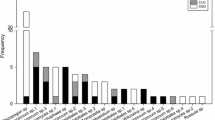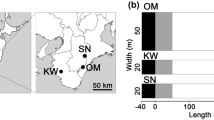Abstract
Ectomycorrhizal (EM) fungi incorporation in nursery production is necessary for afforestation with exotic tree species and native forests restoration programs. The fact that spore use as EM inocula is inexpensive and effective, makes it an option more realistic than vegetative inoculum production for many regions around the world. To determine spore activity from EM species selected as inoculants for Nothofagus pumilio and exotic conifers planted in Patagonia, two conservation methods were applied (i.e., dried fruit bodies and spore slurries), and their change over time was assessed (over 8–9 months). Spore activity decreased significantly with time for both native and exotic EM species. Conservation methods showed no significant differences for N. pumilio EM species considered together or for exotic conifer EM species. However, spore activity of different EM species behaved differently with conservation method and over time when considered separately. Taxa which better kept spore activity over time were Austropaxillus statuum and Setchelliogaster fragilis for N. pumilio, and Inocybe kauffmanii for exotic conifers. However, considering together fruit body spore density and spore activity, the species Hallingea purpurea and Cortinarius sp. also appeared as suitable for N. pumilio and Rhizopogon roseolus, R. villosulus, Suillus luteus and S. lakei for exotic conifers. Spore density found in EM fungal fructifications were also established in order to estimate fructification weights necessary to apply a reference dose of active spores in inoculation programs.



Similar content being viewed by others
References
An ZQ, Hendrix JW (1988) Determining viability of endogonaceous spores with a vital stain. Mycologia 80:259–261
An ZQ, Guo BZ, Hendrix JW (1998) Viability of soilborne spores of glomalean mycorrhizal fungi. Soil Biol Biochem 30:1133–1136
Barroetaveña C (2004) Estudio de las ectomicorrizas de plantines y plantaciones de pino ponderosa (Pinus ponderosa Dougl. Ex Laws) y pino oregon (Pseutsuga menziesii (Mirb) Franco) en la región Andino Patagónica. PhD Thesis, Universidad Nacional del Comahue, Argentina
Barroetaveña C, Rajchenberg M (2003) Las micorrizas y la producción de plántulas de pino ponderosa en la Patagonia Argentina. Bosque 24(1):3–15
Barroetaveña C, Rajchenberg M, Cázares E (2005) Mycorrhizal fungi in Pinus ponderosa introduced in Central Patagonia (Argentina). Nova Hedwigia 80:453–464
Barroetaveña C, Cázares E, Rajchenberg M (2006) Mycorrhizal fungi of Pseudotsuga menziesii, an introduced tree species in Central Patagonia (Argentina). Nova Hedwigia 83:53–66
Barroetaveña C, Bassani VN, Rajchenberg M (2012) Inoculación micorrícica de Pinus ponderosa en la Patagonia Argentina: colonización de las raíces, descripción de morfotipos y crecimiento de las plántulas en vivero. Bosque 33(2):163–169
Bassani VN (2010) Conservación y actividad de esporas de hongos ectomicorrícicos seleccionados para inocular lenga y coníferas exóticas. Undergraduate final seminar. Universidad Nacional de la Patagonia, Argentina
Brundrett M, Bougher N, Dell B, Grove T, Malajczuk N (1996) Working with mycorrizas in forestry and agriculture, Monograph 32. Australian Centre for International Agricultural Research, Canberra
Brundrett M, Malajczuk N, Mingqin G, Daping X, Snelling S, Dell B (2005) Nursery inoculation of Eucalyptus seedlings in Western Australia and Southern China using spores and mycelial inoculum of diverse ectomycorrhizal fungi from different climatic regions. Forest Ecol Manag 209:193–205
Castellano M, Molina R (1989) Mycorrhizae. In: Landis T, Tinus R, Mc Donald S, Barnett J (eds) The Container Tree Nursery Manual vol. 5 Agric Handbk 674. USDA-Forest Service, Washington, DC, pp 101–167
Castellano M, Muchovej J (1996) Truffle-like fungi from South America: Hysterangium sensu lato. Mycotaxon 57:329–345
Chakravarty P, Chatarpaul L (1990) Effect of fertilization on seedling growth, ectomycorrhizal symbiosis, and nutrient uptake in Larix laricina. Can J For Res 20:245–248
Chen YL, Dell B, Malajczuk N (2006) Effect of Scleroderma spore density and age on mycorrhiza formation and growth of containerized Eucalyptus globulus and E. urophylla seedlings. New Forest 31:453–467
Estadística de Incendios Forestales (1999–2012) Programa Nacional de Estadística Forestal, Secretaría de Ambiente y Desarrollo Sustentable de la Nación, Argentina. http://www.ambiente.gov.ar/?idarticulo=7816
Fontenla S, Godoy R, Rosso P, Havrylenko M (1998) Root associations in Austrocedrus forests and seasonal dynamics of arbuscular mycorrhizas. Mycorrhiza 8:29–33
Gagnon J, Langlois CG, Fortin JA (1988) Growth and ectomycorrhiza formation of containerized black spruce seedlings as affected by nitrogen fertilization, inoculum type, and symbiont. Can J Forest Res 18:922–929
Gamundí IJ, Horak E (1993) Hongos de los Bosques Andino-patagónicos. Vázquez Mazzini Editores, Buenos Aires, Argentina
Garrido NN (1988) Agaricales s. l. und ihre Mykorrhizen in den Nothofagus-Waldern Mittelchiles. Bibliotheca Mycologica Band 120, Berlin, Stuttgart
Hamel C, Fyles H, Smith DL (1990) Measurement of development of endomycorrhizal mycelium using three vital stains. New Phytol 115:297–302
Horak E (1980) Fungi, Basidiomycetes, Agaricales y Gasteromycetes secotioides. Flora Criptogámica de Tierra del Fuego, Buenos Aires, Argentina
Jasper DA, Robson AD, Abbott LK (1987) The effect of surface mining on the infectivity of vesicular-arbuscular mycorrhizal fungi. Aust J Bot 35(6):641–652
Kuek C (1994) Issues concerning the production and use of inocula of ectomycorrhizal fungi in increasing the economic productivity of plantations. In: Robson AD, Abbott LK, Malajczuk N (eds) Management of mycorrhizas in agriculture, horticulture and forestry. Kluwer, The Netherlands, pp 221–230
Martínez DB, Barroetaveña C, Rajchenberg M (2007) Micorrización de plántulas de Pinus ponderosa en la etapa de vivero. Las influencias del régimen de fertilización y del momento de aplicación del inóculo en el grado de micorrización. Bosque 28:226–233
Marx DH, Jarl K, Ruehle JL, Bell W (1984) Development of Pisolithus tinctorius ectomycorrhizae on pine seedlings using basidiospore-encapsulated seeds. Forest Sci 30:897–907
Miller SL, Torres P, McLean TM (1993) Basidiospore viability, dormancy, activation and germination in ectomycorrhizal and saprotrophic Basidiomycetes. Mycol Res 97:141–147
Parladé J, Pera J, Alvarez I (1996) Inoculation of containerized Pseudotsuga menziesii and Pinus pinaster seedlings with spores of five species of ectomycorrhizal fungi. Mycorrhiza 6:237–245
Pera J, Parladé J (2005) Inoculación controlada con hongos ectomicorrícicos en la producción de planta destinada a repoblaciones forestales: estado actual en España. Inves Agrar: Sist Recur For 14(3):419–433
Rincón A, de Felipe M, Fernández-Pascual M (2007) Inoculation of Pinus halepensis Mill. With selected ectomycorrhizal fungi improves seedling establishment 2 years after planting in a degraded gypsum soil. Mycorrhiza 18:23–32
Salgado Salomon ME, Barroetaveña C, Rajchenberg M (2011) Do pine plantations provide mycorrhizal inocula for seedlings establishment in grasslands from Patagonia, Argentina? New Forest 41(2):191–205
Schubert A, Marzachi C, Mazzitelli M, Cravero MC, Bonfante-Fasolo P (1987) Development of total and viable extraradical mycelium in the vesicular-arbuscular mycorrhizal fungus Glomus clarum Nicol & Schenck. New Phytol 107:183–190
Singer R (1969) Mycoflora Australis. Nova Hedwigia. CHR, Belser, Stuttgart
Smith SE, Read D (2009) Mycorrhizal symbiosis, 3rd edn. Academic Press, Cambridge
Steel RG, Torrie JH (1988) Bioestadistica: Principios y procedimientos. Mc Graw-Hill, USA
Sylvia DM (1987) Activity of external hyphae of vesicular-arbuscular mycorrhizal fungi. Soil Biol Biochem 20:39–43
Sylvia DM (1990) Distribution structure and function of external hyphae of vesicular-arbuscular mycorrhizal fungi. In: Box JE, Hammond LC (eds) Rhizosphere dynamics. Westview Press, Boulder, pp 144–167
Theodorou C (1984) Mycorrhizal inoculation of pine nurseries by spraying basidiospores onto soil prior to sowing. Aust For 47:76–78
Torres P, Honrubia M (1994) Basidiospores viability in stored slurries. Mycol Res 98(5):527–530
Trappe JM (1977) Selection of fungi for ectomycorrhizal inoculation in nurseries. Annu Rev Phytopathol 15:203–222
Valenzuela Flores E (1993) Estudio sistemático, corológico y ecológico de los Agaricales Sensu Lato de los bosques autóctonos de la Región de los Lagos en Chile. PhD Thesis, Universidad de Alcalá de Henares, Facultad de Ciencias, Spain
Vázquez DP (2002) Multiple effects of introduced mammalian herbivores in a temperate forest. Biol Invasions 4:175–191
Veblen TT, Donoso C, Kitzberger T, Rebertus AJ (1996) Ecology of Southern Chilean and Argentinean Nothofagus forests. In: Veblen TT, Hill RS, Read J (eds) The ecology and biogeography of Nothofagus Forest. Yale University Press, New Heaven, pp 293–353
Veblen TT, Kitzberger T, Raffaele E, Lorenz DC (2003) Fire history and vegetation changes in Northern Patagonia, Argentina. In: Veblen TT, Baker WL, Montenegro G, Swetnam TW (eds) Fire regimes and climatic change in temperate ecosystems of the Western Americas. Springer, Berlin, pp 259–289
Walley FL, Germida JJ (1995) Estimating the viability of vesicular-arbuscular ectomycorrhizal fungal spores using tetrazolium salts as vital stains. Mycologia 87(2):273–279 www.indexfungorum.org
Acknowledgments
We thank projects “Domesticación de especies nativas” by the Instituto Nacional de Tecnología Agropecuaria (INTA), and PIP-CONICET 80101000 for funding this study. Prof. David Ratkowsky (Hobart, Tasmania) kindly reviewed and inproved the English text. Dr. Maria Belén Pildain kindly helped us with the artwork. CB and MR are researchers of the National Research Council of Argentina (CONICET).
Author information
Authors and Affiliations
Corresponding author
Rights and permissions
About this article
Cite this article
Bassani, V.N., Barroetaveña, C. & Rajchenberg, M. Spores of ectomycorrhizal fungi as inoculants for Nothofagus pumilio and exotic conifer seedlings in Patagonia, Argentina: their activity and conservation. New Forests 44, 471–485 (2013). https://doi.org/10.1007/s11056-012-9357-1
Received:
Accepted:
Published:
Issue Date:
DOI: https://doi.org/10.1007/s11056-012-9357-1




